Effectiveness of Magnetized Flow on Nanofluid Containing Gyrotactic Micro-Organisms over an Inclined Stretching Sheet with Viscous Dissipation and Constant Heat Flux
Abstract
1. Introduction
2. Mathematical Formulation
3. Numerical Procedure
4. Results and Discussion
5. Conclusions
- It was found that an increase in the value of the Grashof number tends to minimize the local skin friction coefficient and maximize local Nusselt number, local Sherwood number, and local density of the motile micro-organisms.
- Increasing the value of the Eckert number reduces the local skin friction coefficient and local Nusselt number, whereas both the Sherwood number and the density of the motile micro-organisms decrease.
- An increment in the magnetic field parameter increases the skin friction coefficient and decreases the Nusselt and Sherwood numbers and local density of the motile micro-organisms number due to the presence of Lorentz force.
- An increase in the value of Brownian motion number, thermophoresis parameter, and Lewis number raise local Sherwood number and local density of the motile micro-organisms, whereas the local skin friction coefficient and local Nusselt number demonstrate the opposite behavior with this increase.
- An increase in the buoyancy ratio parameter and bioconvection Rayleigh number tend to decrease the local Nusselt number, local Sherwood number, and local density of the motile micro-organisms number, whereas the local skin friction coefficient decreases.
- As increments in the bioconvection Lewis number, bioconvection Peclet number or bioconvection constant, local Nusselt number, local Sherwood number, and local density of the motile micro-organisms number increase, the local skin friction coefficient decreases with these increases.
Author Contributions
Funding
Data Availability Statement
Acknowledgments
Conflicts of Interest
Nomenclature
| b | Chemotaxis constant |
| B0 | Magnetic induction |
| C | Concentration |
| DB | Brownian diffusion coefficient |
| Dm | Thermophoresis diffusion coefficient |
| DT | Diffusivity of micro-organisms |
| Ec | Eckert number |
| f’ | Dimensionless velocity |
| g | Acceleration due to gravity |
| Gr | Grashof number |
| K | Thermal conductivity of fluid |
| Lb | Biconvection Lewis number |
| Le | Traditional Lewis number |
| M | Magnetic field parameter |
| N | Number density of motile micro-organisms |
| Nb | Brownian motion parameter |
| Nt | Thermophoresis parameter |
| Nr | Buoyancy ratio parameter |
| Pe | Biconvection Peclet number |
| Pr | Prandtl number |
| Rb | Biconvection Rayleigh number |
| Rex | Reynolds number |
| T | Temperature |
| u | Velocity component in x-direction |
| v | Velocity component in y-direction |
| Wc | The utmost cell swimming speed |
| x | Horizontal co-ordinate |
| y | Vertical co-ordinate |
| Greek symbols | |
| α | Thermal diffusivity of the fluid |
| β | Thermal expansion coefficient |
| γ | Micro-organism average volume |
| ϑ | Angle of inclination |
| τ | The ratio of effective heat capacity among the nanoparticle material and base fluid |
| τw | Shear stress coefficient |
| χ | Dimensionless density of motile micro-organisms |
| η | Dimensionless co-ordinate |
| λ | Electric conductivity of the fluid |
| μ | Dynamic viscosity |
| υ | Kinematic viscosity |
| θ | Dimensionless temperature |
| φ | Dimensionless concentration |
| Ψ | Stream function |
| ρ | Density of the fluid |
| ρf | base fluid density |
| ρ∞ | Micro-organism density |
| ρp | Nanoparticle density |
| σ | Bioconvection constant |
| Subscript | |
| w | Wall condition |
| ∞ | Ambient condition |
| Superscript | |
| ‘ | Differentiation with respect to η; |
References
- Crane, L.J. Flow past a stretching plane. Z. Angew. Math. Phys. 1970, 21, 645–647. [Google Scholar] [CrossRef]
- Gupta, P.S.; Gupta, A.S. Heat and mass transfer on a stretching sheet with suction or blowing. Can. J. Chem. Eng. 1977, 55, 744–746. [Google Scholar]
- Soundalgekar, V.M.; Murty, T.V.R. Heat transfer in flow past a continuous moving plate with variable temperature. Heat Mass Transf. 1980, 14, 91–93. [Google Scholar] [CrossRef]
- Grubka, L.J.; Bobba, K.M. Heat Transfer Characteristics of a Continuous, Stretching Surface with Variable Temperature. J. Heat Transf. 1985, 107, 248–250. [Google Scholar] [CrossRef]
- Choi, S. Enhancing thermal conductivity of fluids with nanoparticle. In Developments and Applications of Non-Newtonian Flows; ASME MD vol. 231 and FED vol. 66; Siginer, D.A., Wang, H.P., Eds.; ASME: New York, NY, USA, 1995; pp. 99–105. [Google Scholar]
- Tlili, I.; Nabwey, H.A.; Reddy, M.; Sandeep, N.; Pasupula, M. Effect of resistive heating on incessantly poignant thin needle in magnetohydrodynamic Sakiadis hybrid nanofluid. Ain Shams Eng. J. 2021, 12, 1025–1032. [Google Scholar] [CrossRef]
- El-Kabeir, S.M.M.; Chamkha, A.J.; Rashad, A.M. The Effect of Thermal Radiation on Non-Darcy Free Convection from a Vertical Cylinder Embedded in a Nanofluid Porous Media. J. Porous Media 2014, 17, 269–278. [Google Scholar] [CrossRef]
- Tlili, I.; Nabwey, H.A.; Samrat, S.P.; Sandeep, N. 3D MHD nonlinear radiative flow of CuO-MgO/methanol hybrid nanofluid beyond an irregular dimension surface with slip effect. Sci. Rep. 2020, 10, 9181. [Google Scholar] [CrossRef] [PubMed]
- Nabwey, H.A.; Boumazgour, M.; Rashad, A.M. Group method analysis of mixed convection stagnation-point flow of non-Newtonian nanofluid over a vertical stretching surface. Indian J. Phys. 2017, 91, 731–742. [Google Scholar] [CrossRef]
- Tlili, I.; Sandeep, N.; Reddy, M.G.; Nabwey, H.A. Effect of radiation on engine oil-TC4/NiCr mixture nanofluid flow over a revolving cone in mutable permeable medium. Ain Shams Eng. J. 2020, 11, 1255–1263. [Google Scholar] [CrossRef]
- Rashad, A. Impact of thermal radiation on MHD slip flow of a ferrofluid over a non-isothermal wedge. J. Magn. Magn. Mater. 2017, 422, 25–31. [Google Scholar] [CrossRef]
- Chamkha, A.J.; Rashad, A.M.; El-Zahar, E.R.; El-Mky, H.A. Analytical and Numerical Investigation of Fe3O4-Water Nanofluid Flow Over a Moveable Plane in A Parallel Stream With High Suction. Energies 2019, 12, 198. [Google Scholar] [CrossRef]
- Rashad, A.M.; Nabwey, H.A. Gyrotactic Mixed Bioconvection Flow of a Nanofluid Past a Circular Cylinder with Convective Boundary Condition. J. Taiwan Inst. Chem. Eng. 2019, 99, 9–17. [Google Scholar] [CrossRef]
- Nabwey, H.A.; Khan, W.A.; Rashad, A.M. Lie Group Analysis of Unsteady Flow of Kerosene/Cobalt Ferrofluid Past a Radiated Stretching Surface with Navier Slip and Convective Heating. Mathematics 2020, 8, 826. [Google Scholar] [CrossRef]
- Hazarika, S.; Ahmed, S.; Chamkha, A.J. Investigation of nanoparticles Cu, Ag and Fe3O4 on thermophoresis and viscous dissipation of MHD nanofluid over a stretching sheet in a porous regime: A numerical modeling. Math. Comput. Simul. 2021, 182, 819–837. [Google Scholar] [CrossRef]
- Narender, G.; Govardhan, K.; Sarma, G.S. Numerical Study of Radiative Magnetohydrodynamics Viscous Nanofluid Due to Convective Stretching Sheet with the Chemical Reaction Effect. Iraqi J. Sci. 2020, 61, 1733–1744. [Google Scholar] [CrossRef]
- Mansour, M.; Ahmed, S.E.; Rashad, A.M. MHD Natural Convection in a Square Enclosure using Nanofluid with the Influence of Thermal Boundary Conditions. J. Appl. Fluid Mech. 2016, 9, 2515–2525. [Google Scholar] [CrossRef]
- Khan, M.; Hussain, A.; Malik, M.; Salahuddin, T.; Khan, F. Boundary layer flow of MHD tangent hyperbolic nanofluid over a stretching sheet: A numerical investigation. Results Phys. 2017, 7, 2837–2844. [Google Scholar] [CrossRef]
- Pourmehran, O.; Rahimi-Gorji, M.; Ganji, D. Heat transfer and flow analysis of nanofluid flow induced by a stretching sheet in the presence of an external magnetic field. J. Taiwan Inst. Chem. Eng. 2016, 65, 162–171. [Google Scholar] [CrossRef]
- Mehryan, M.S.A.; Kashkooli, M.F.; Soltani, M.; Raahemifar, K. Fluid Flow and Heat Transfer Analysis of a Nanofluid Containing Motile Gyrotactic Micro-Organisms Passing a Nonlinear Stretching Vertical Sheet in the Presence of a Non-Uniform Magnetic Field; Numerical Approach. PLoS ONE 2016, 11, 0157598. [Google Scholar] [CrossRef]
- Khan, J.A.; Mustafa, M.; Hayat, T.; Alsaedi, A. Numerical study on three-dimensional flow of nanofluid past a convectively heated exponentially stretching sheet. Can. J. Phys. 2015, 93, 1131–1137. [Google Scholar] [CrossRef]
- Akbar, N.S.; Khan, Z. Magnetic field analysis in a suspension of gyrotactic microorganisms and nanoparticles over a stretching surface. J. Magn. Magn. Mater. 2016, 410, 72–80. [Google Scholar] [CrossRef]
- Hayat, T.; Imtiaz, M.; Alsaedi, A. Magnetohydrodynamic flow of nanofluid over permeable stretching sheet with convective boundary conditions. Therm. Sci. 2016, 20, 1835–1845. [Google Scholar] [CrossRef]
- Khan, W.A.; Makinde, O.D. MHD Nanofluid Bioconvection Due to Gyrotactic Microorganisms over a Convectively Heat Stretching Sheet. Int. J. Therm. Sci. 2014, 81, 118–124. [Google Scholar]
- Khan, W.A.; Rashad, A.M.; Abdou, M.M.M.; Tlili, I. Natural bioconvection flow of a nanofluid containing gyrotactic microorganisms about a truncated cone. Eur. J. Mech. B Fluids 2019, 75, 133–142. [Google Scholar] [CrossRef]
- Chamkha, A.; Rashad, A.M.; Kameswaran, P.K.; Abdou, M.M.M. Radiation Effects on Natural Bioconvection Flow of a Nanofluid Containing Gyrotactic Microorganisms Past a Vertical Plate with Streamwise Temperature Variation. J. Nanofluids 2017, 6, 587–595. [Google Scholar] [CrossRef]
- Hayat, T.; Bashir, Z.; Qayyum, S.; Alsaedi, A. Nonlinear radiative flow of nanofluid in presence of gyrotactic microorganisms and magnetohydro-dynamic. J. Numer. Methods Heat Fluid Flow 2019, 29, 3039–3055. [Google Scholar] [CrossRef]
- Ferdows, M.; Zaimi, K.; Rashad, A.M.; Nabwey, H.A. MHD Bioconvection Flow and Heat Transfer of Nanofluid through an Exponentially Stretchable Sheet. Symmetry 2020, 12, 692. [Google Scholar] [CrossRef]
- Ali, M.; Alim, A.; Alam, M.S. Similarity Solution of Heat and Mass Transfer Flow over an Inclined Stretching Sheet with Viscous Dissipation and Constant Heat Flux in Presence of Magnetic Field. Procedia Eng. 2015, 105, 557–569. [Google Scholar] [CrossRef]
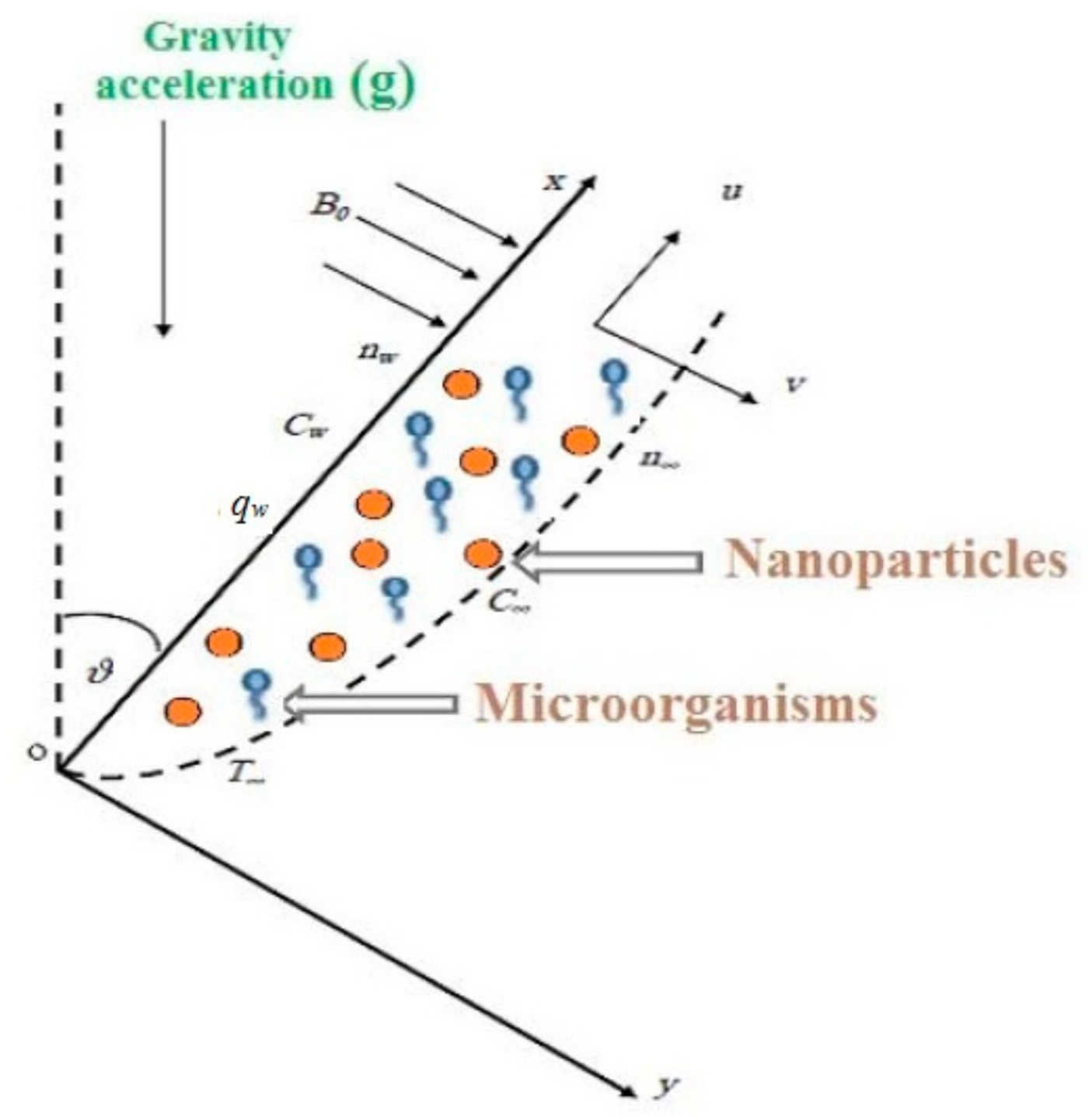
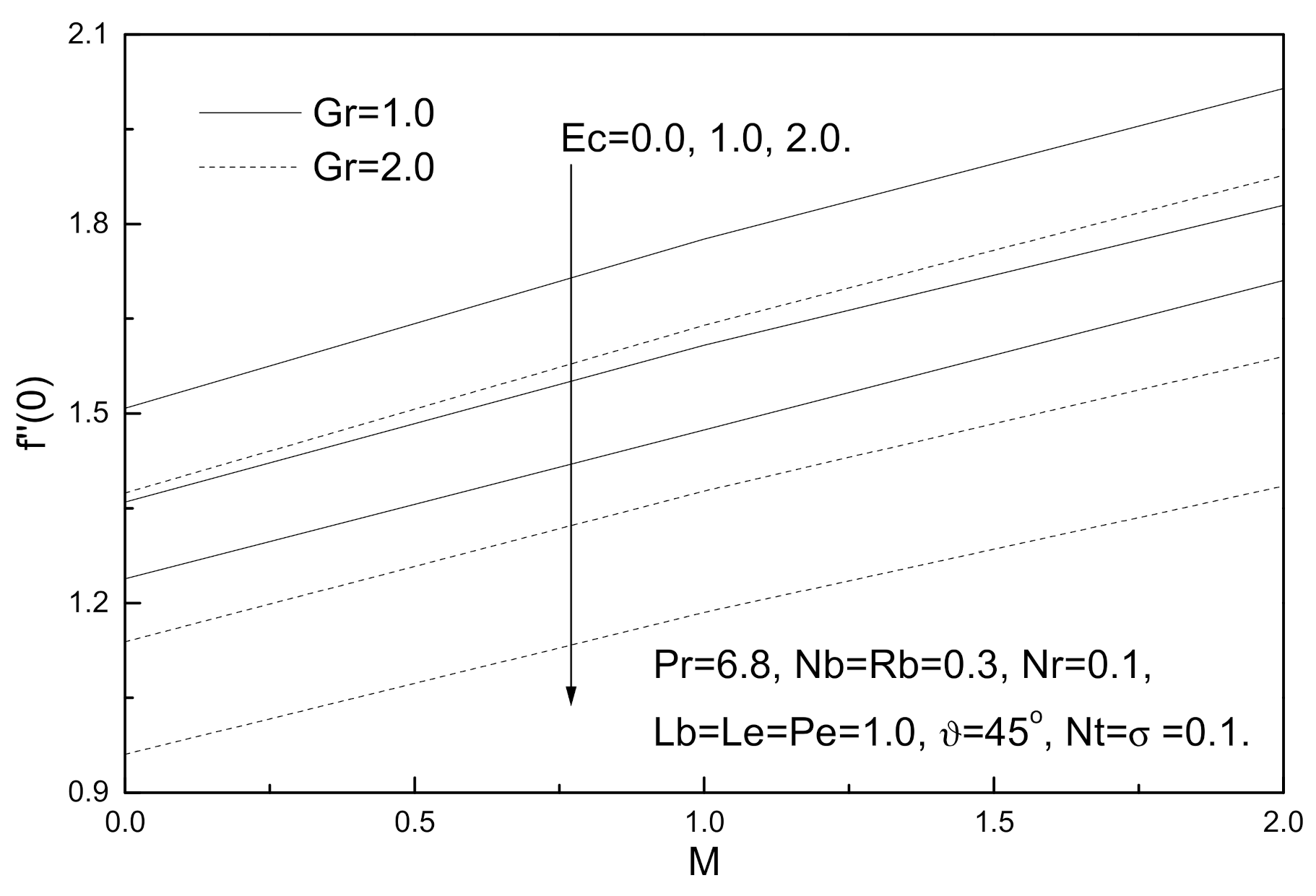
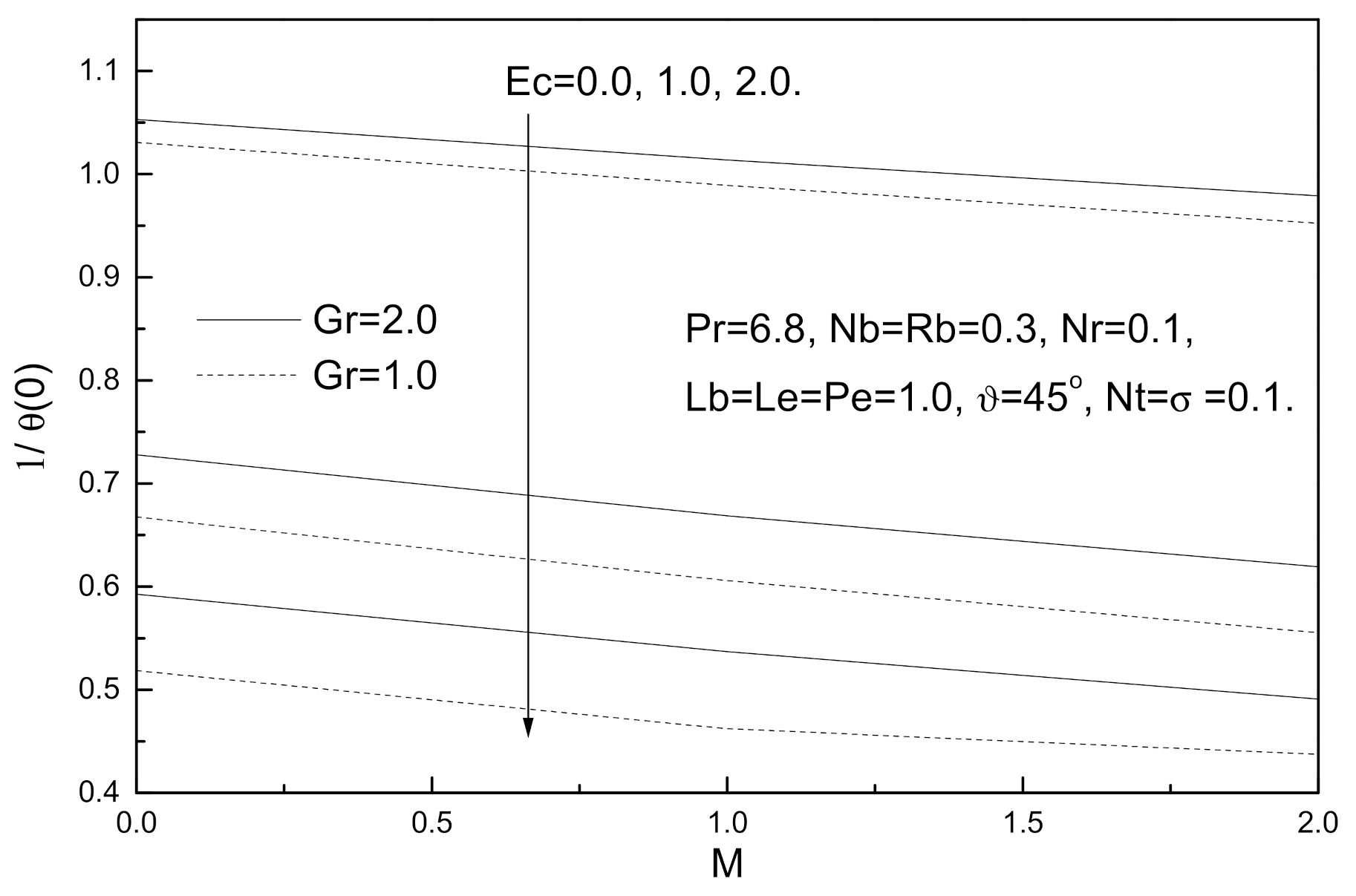
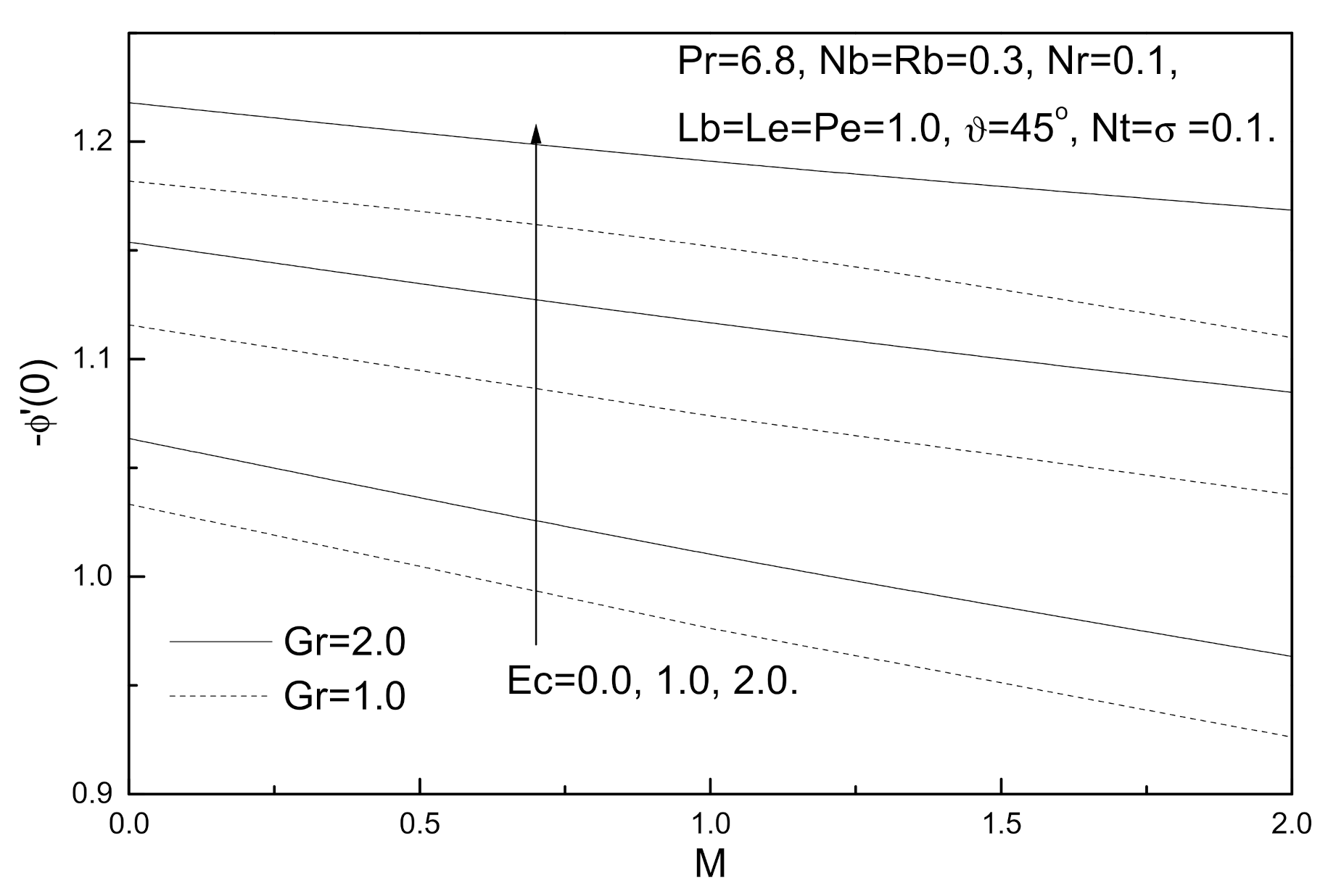
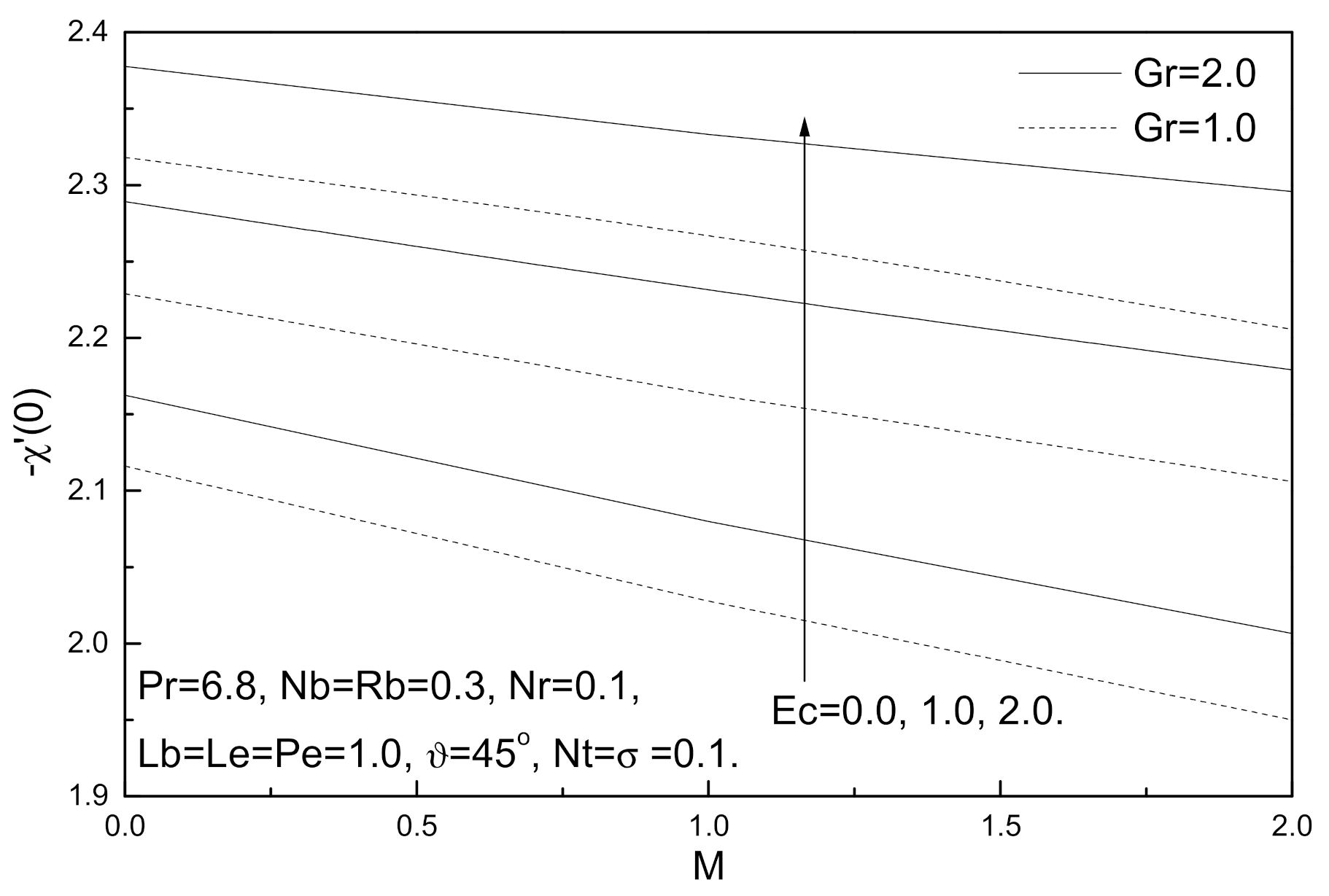

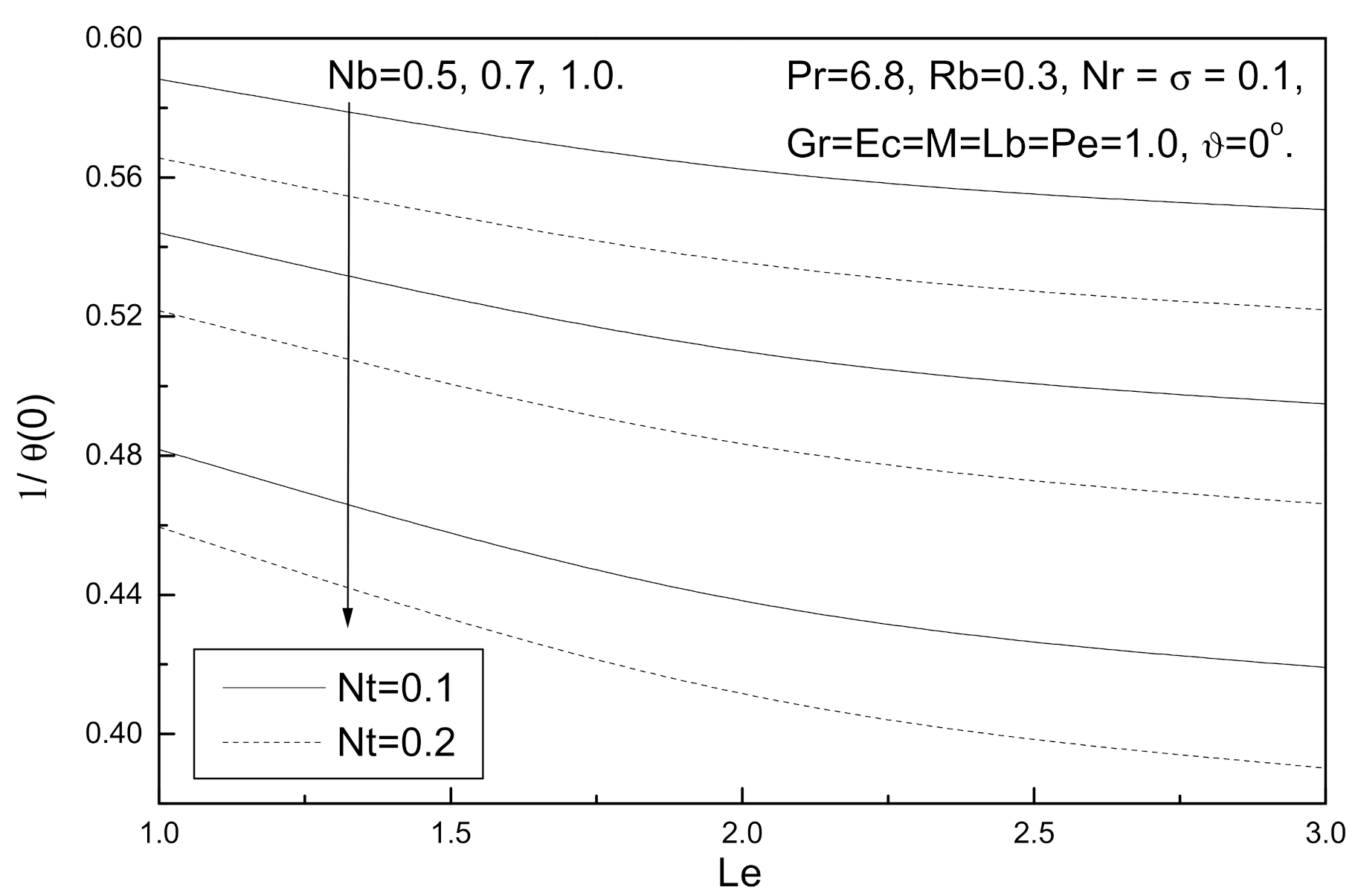
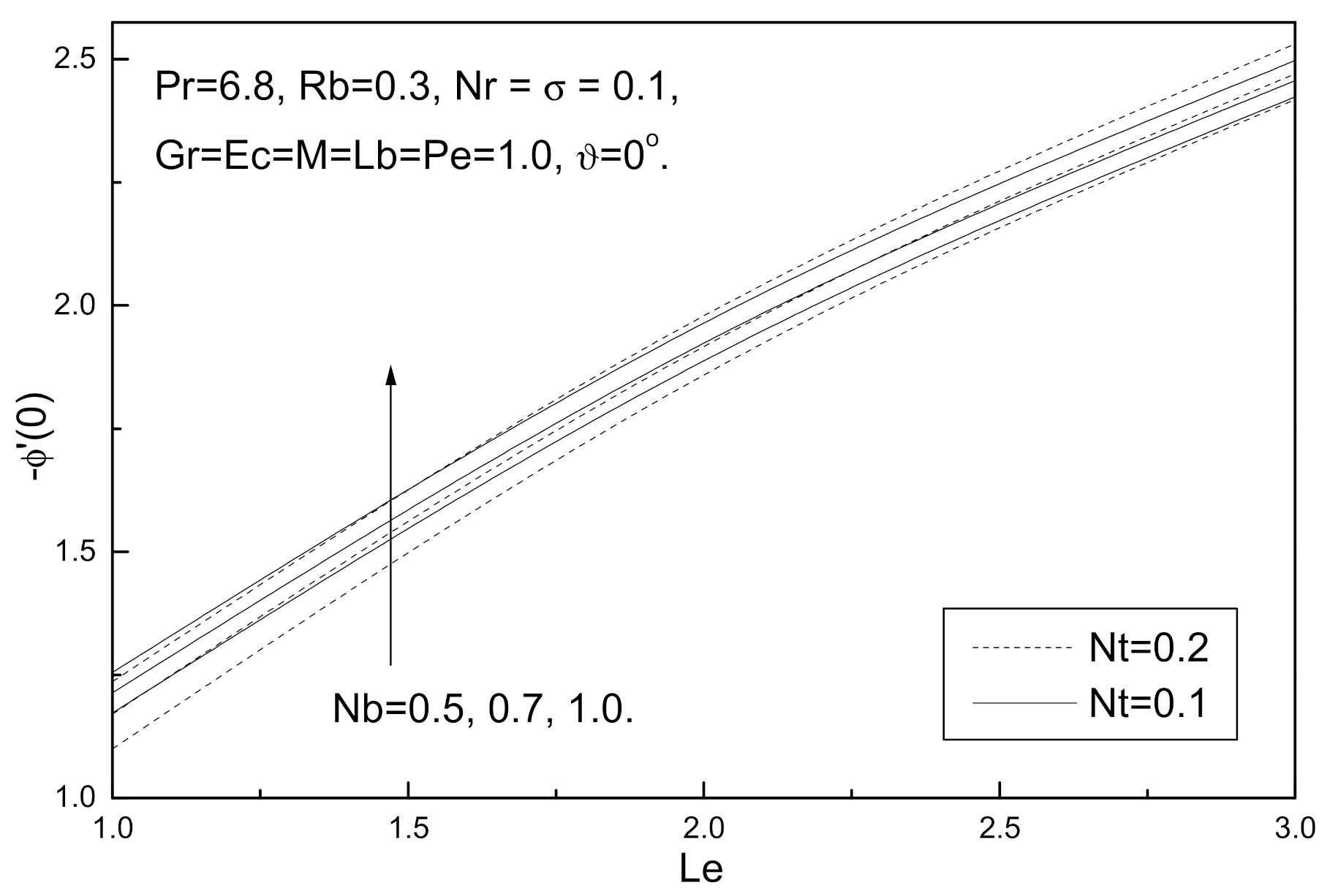
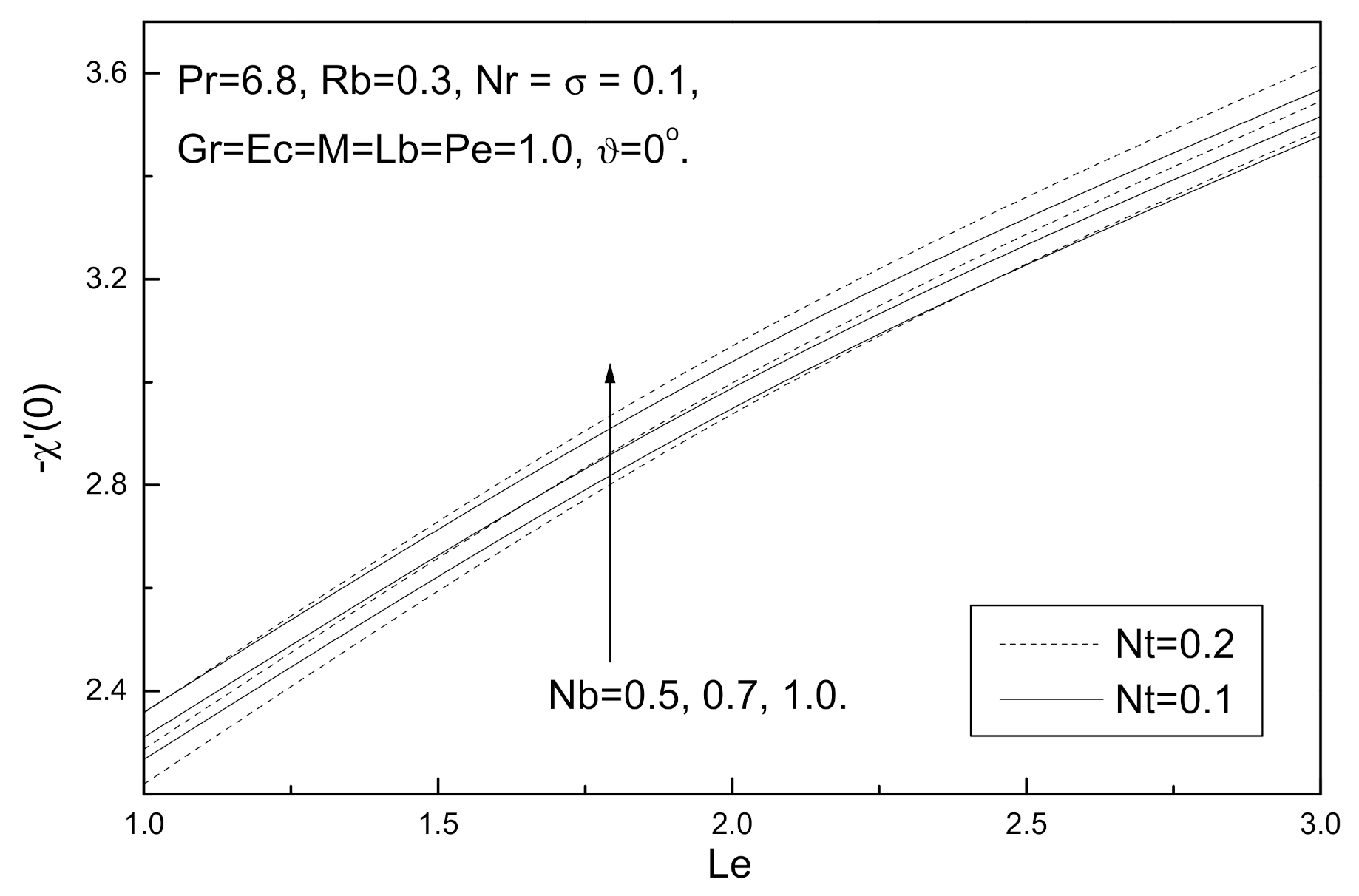
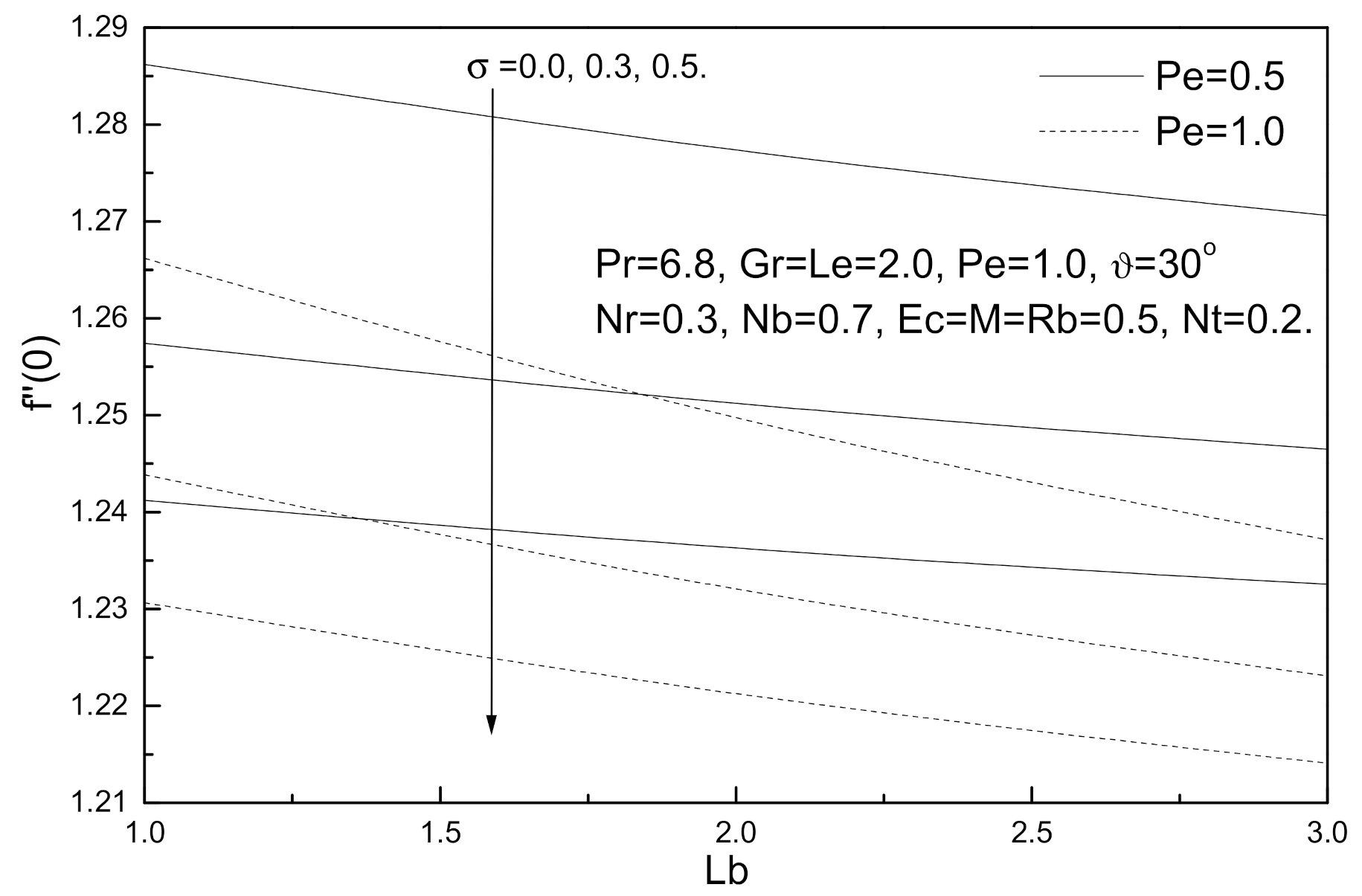
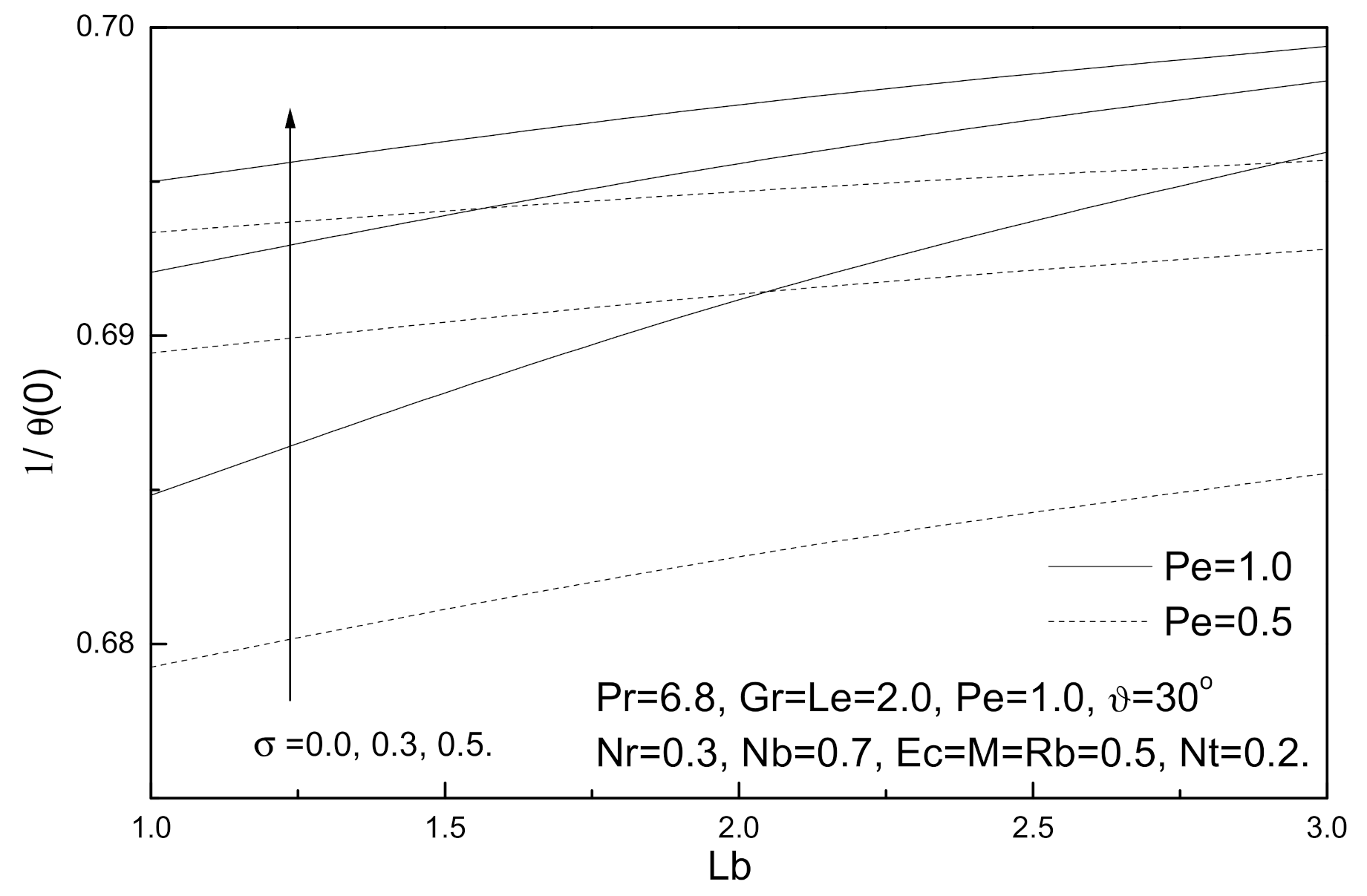
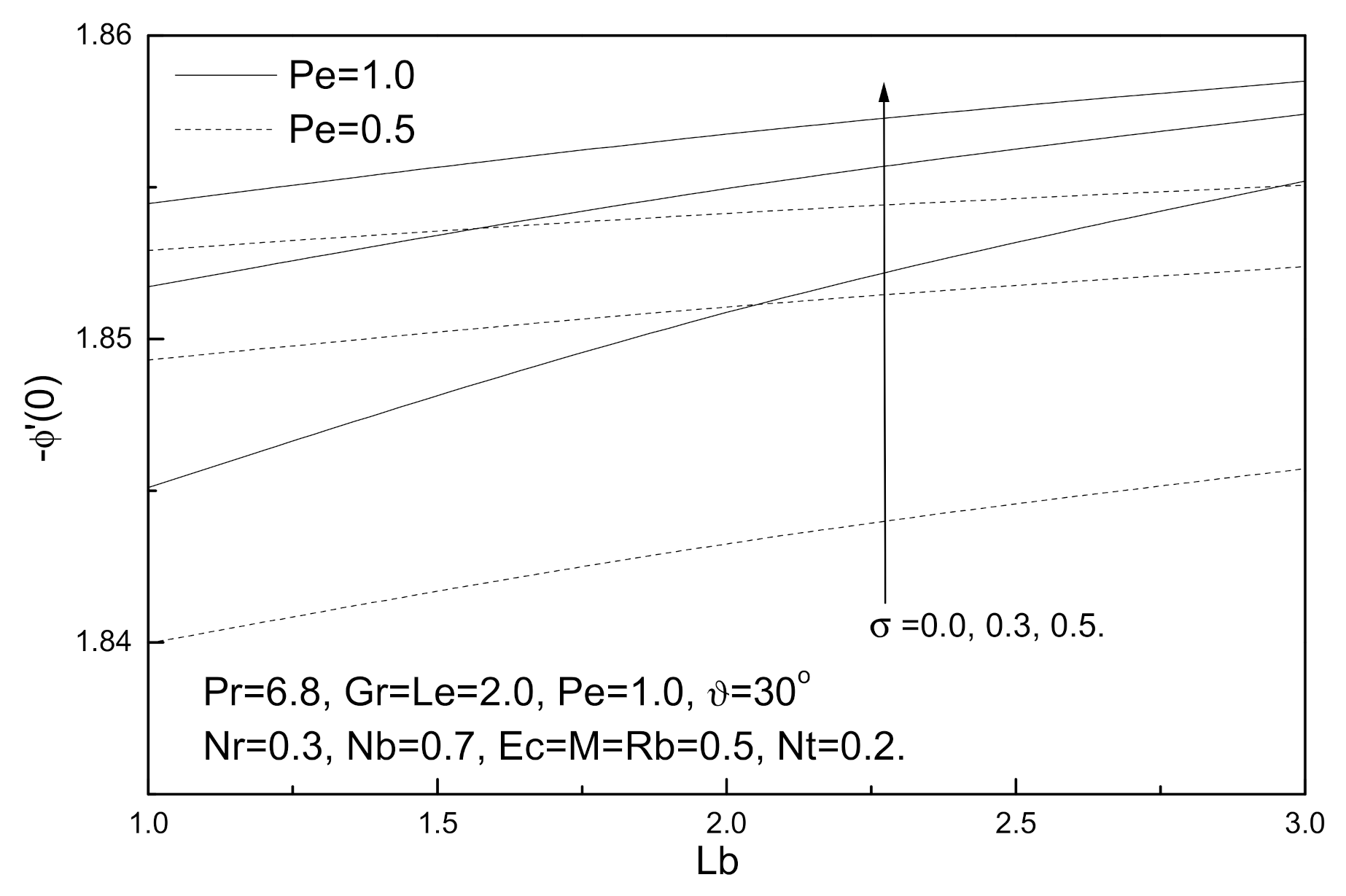

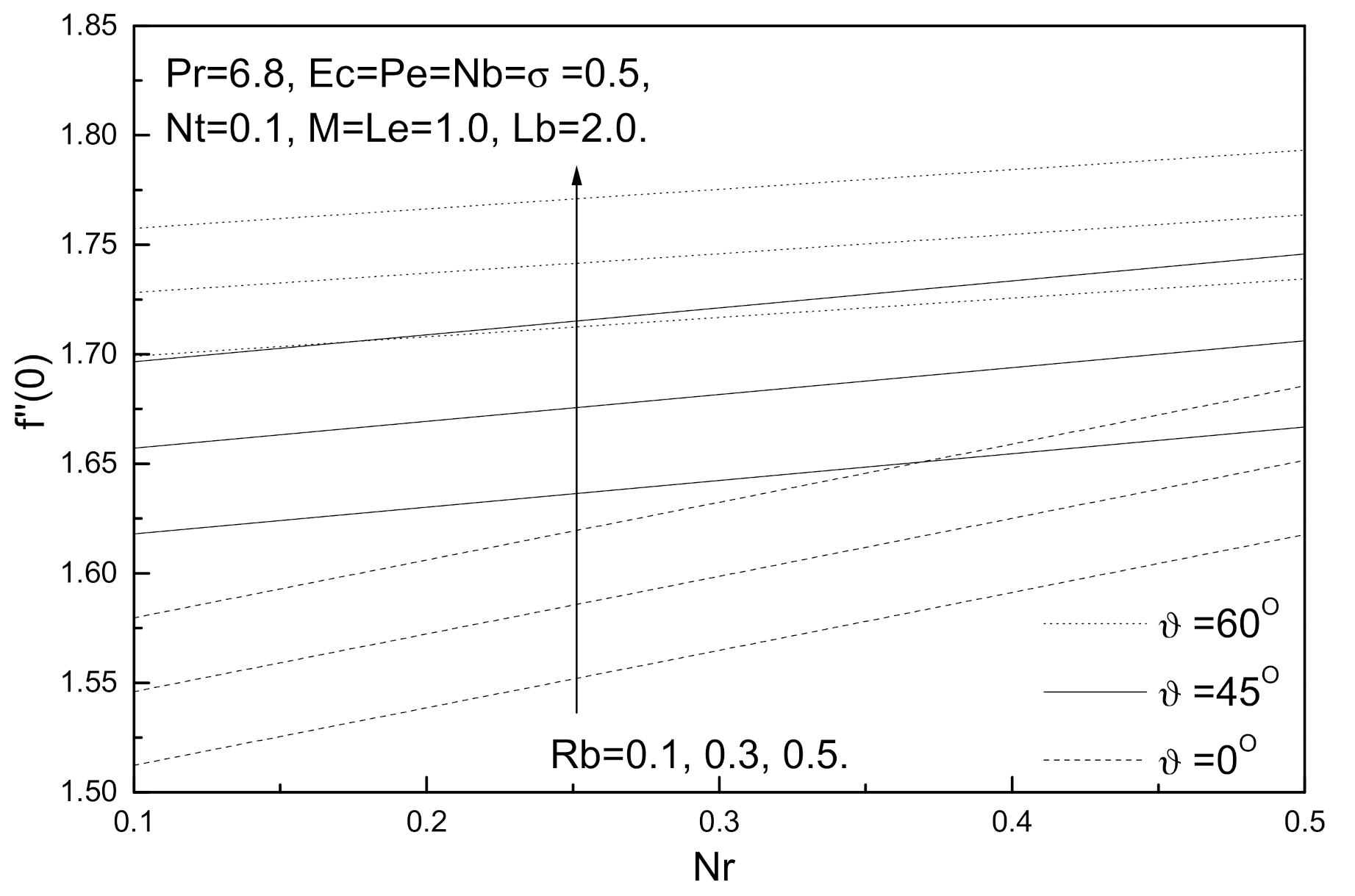
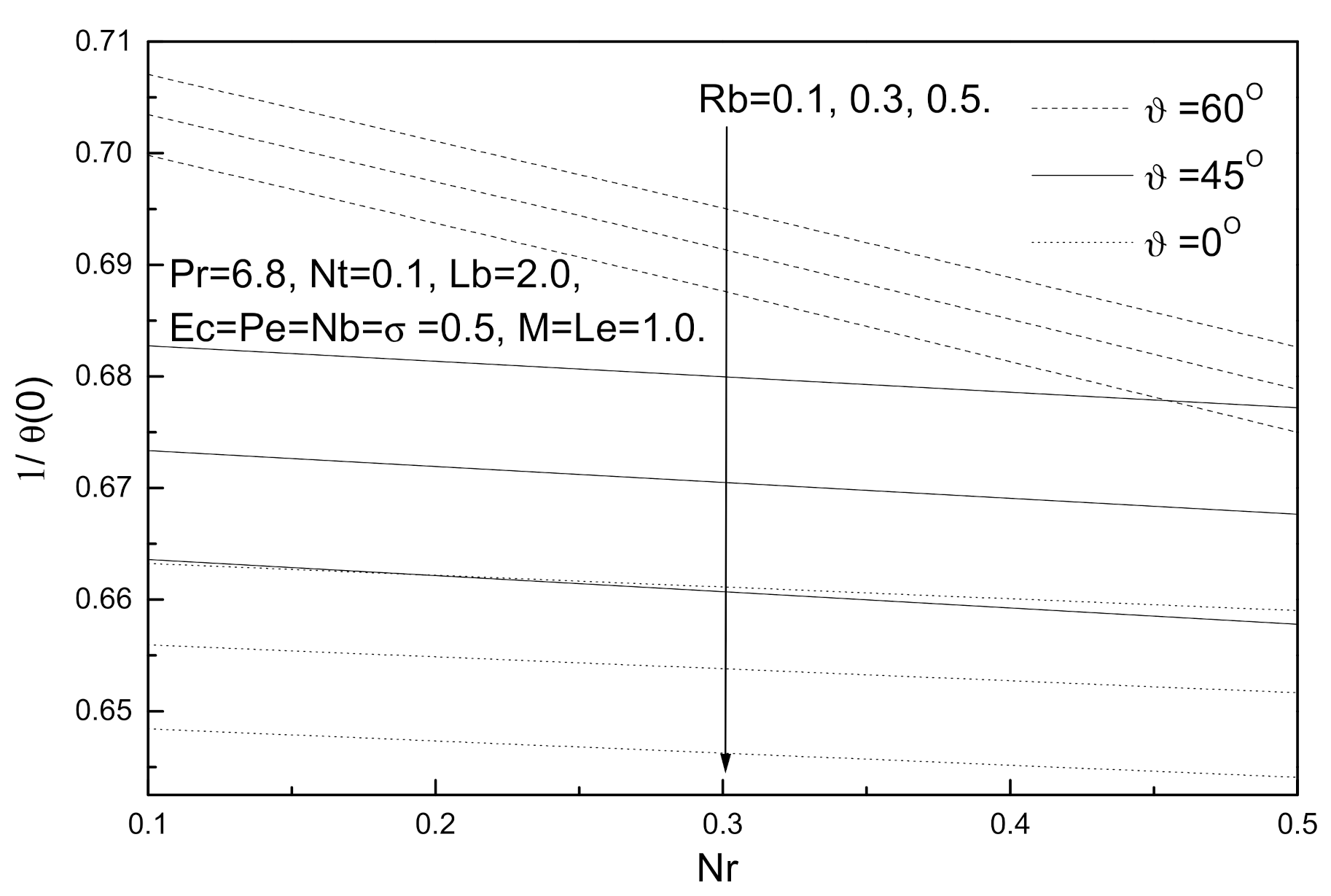
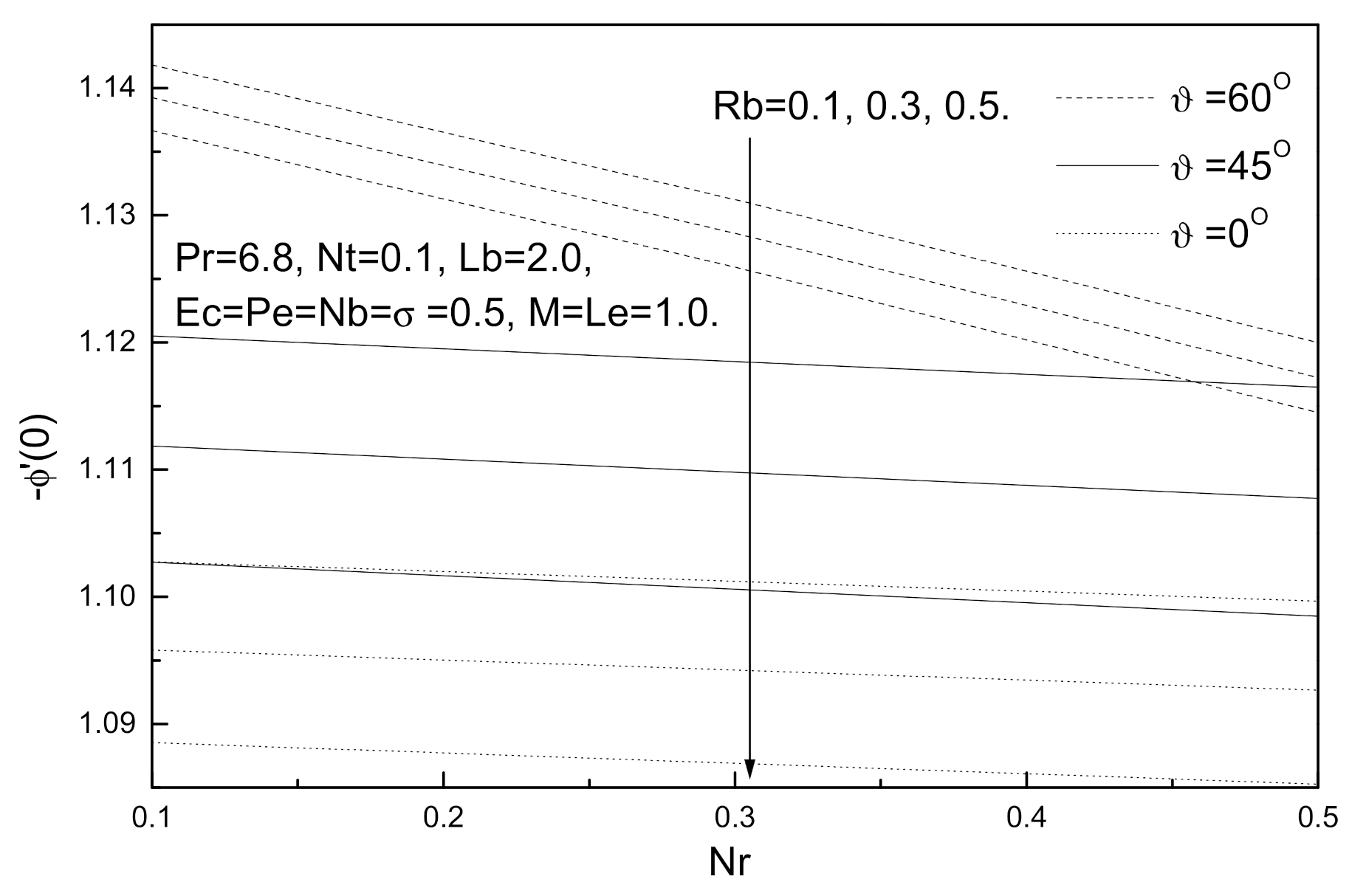

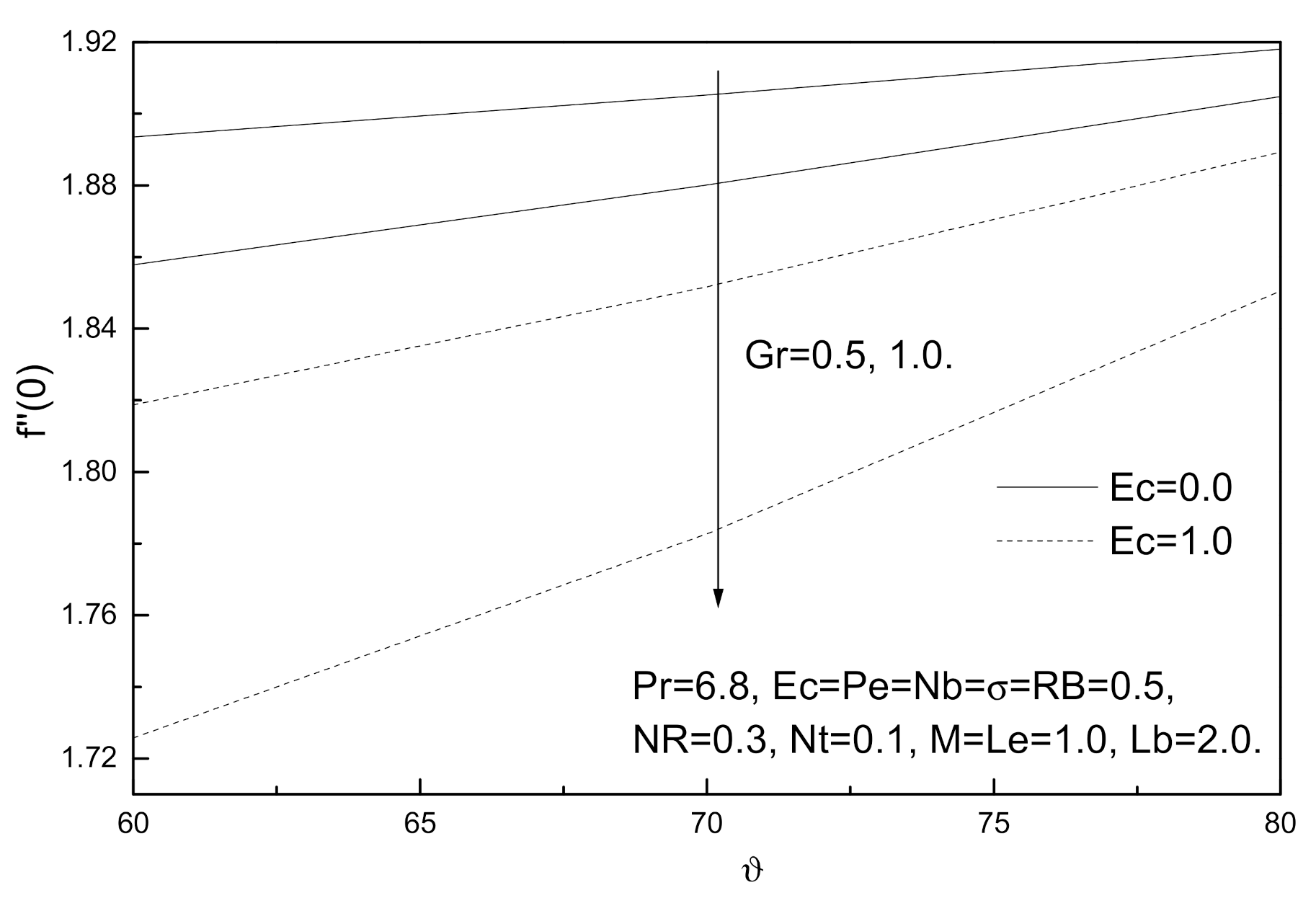
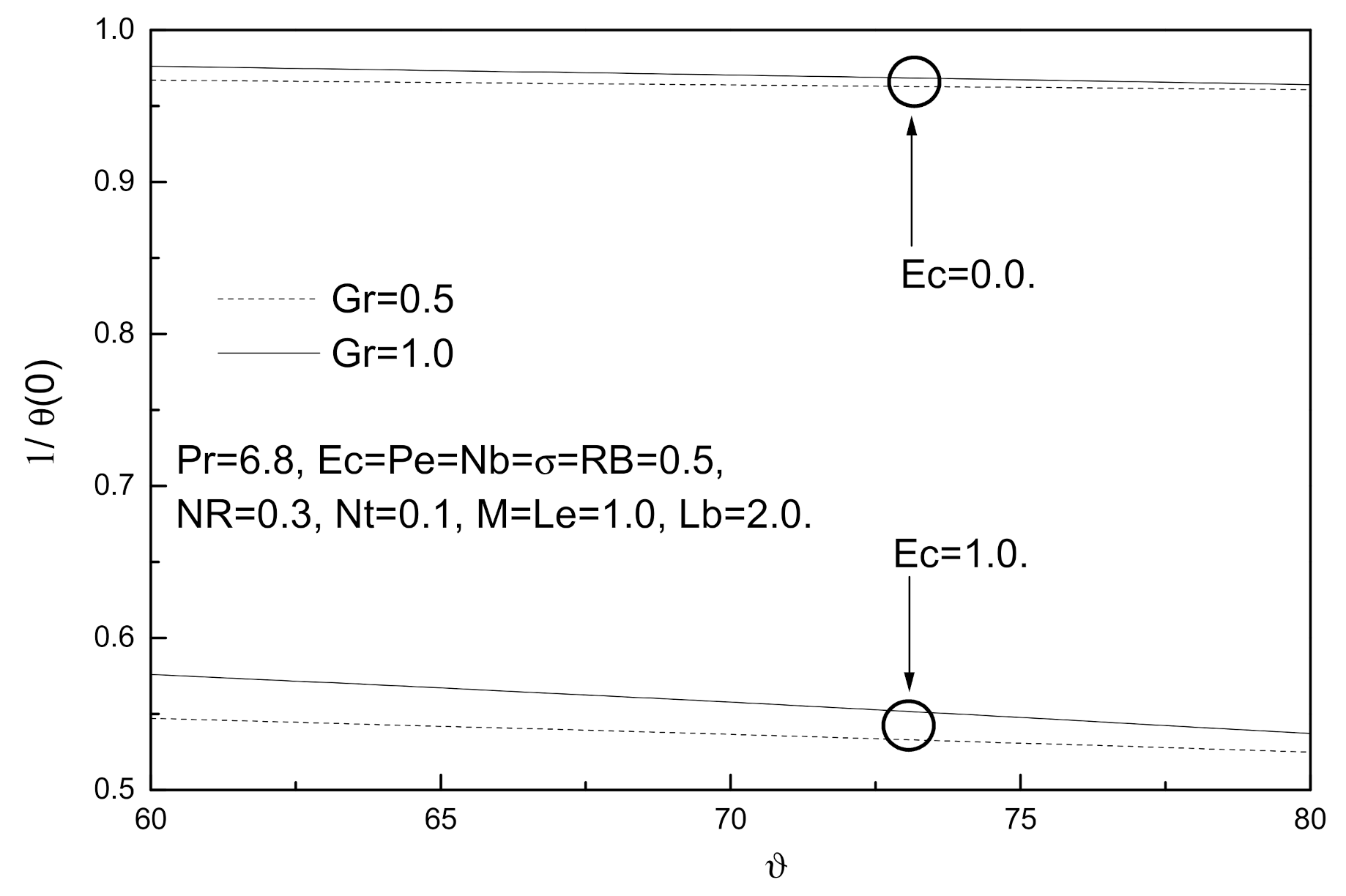
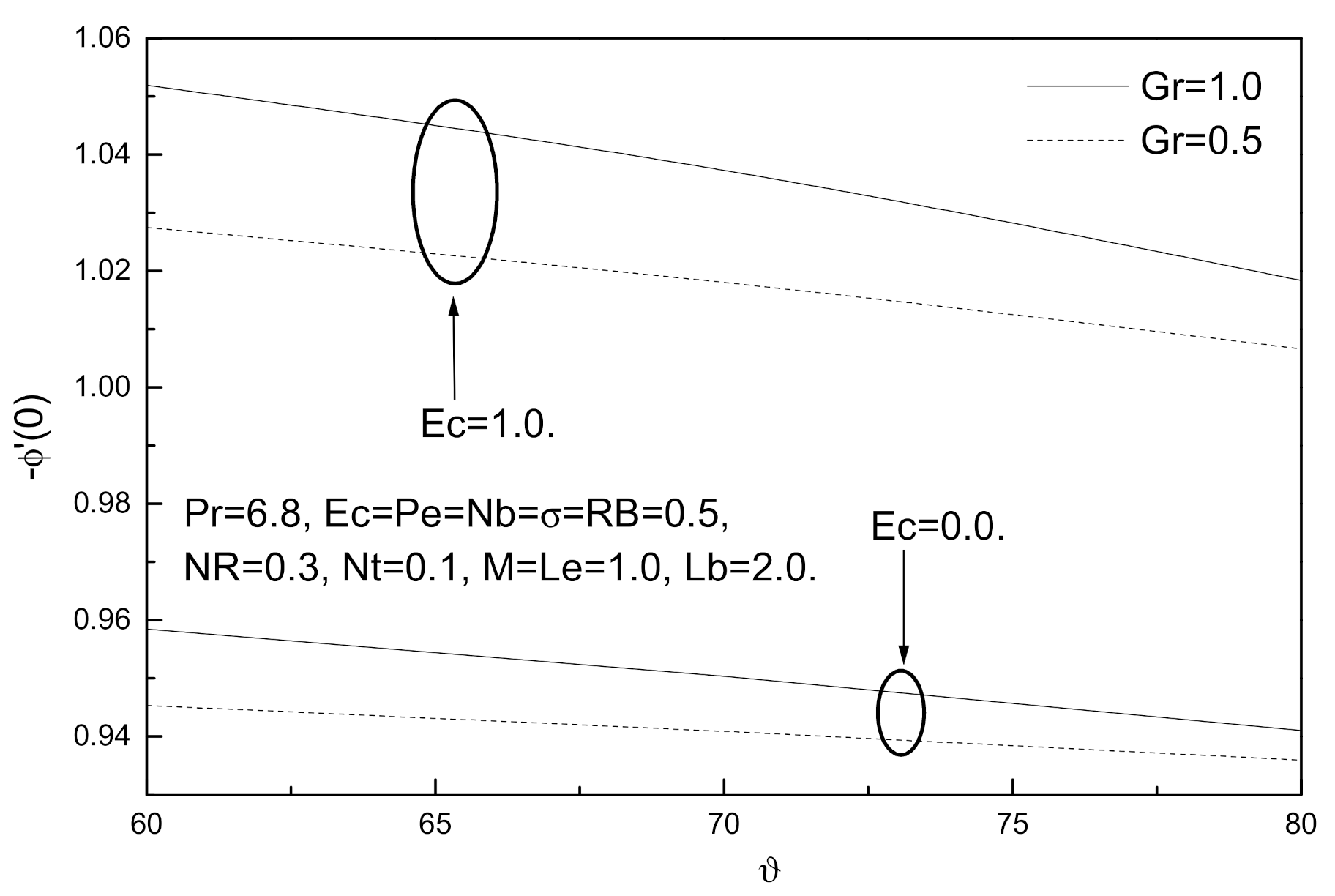
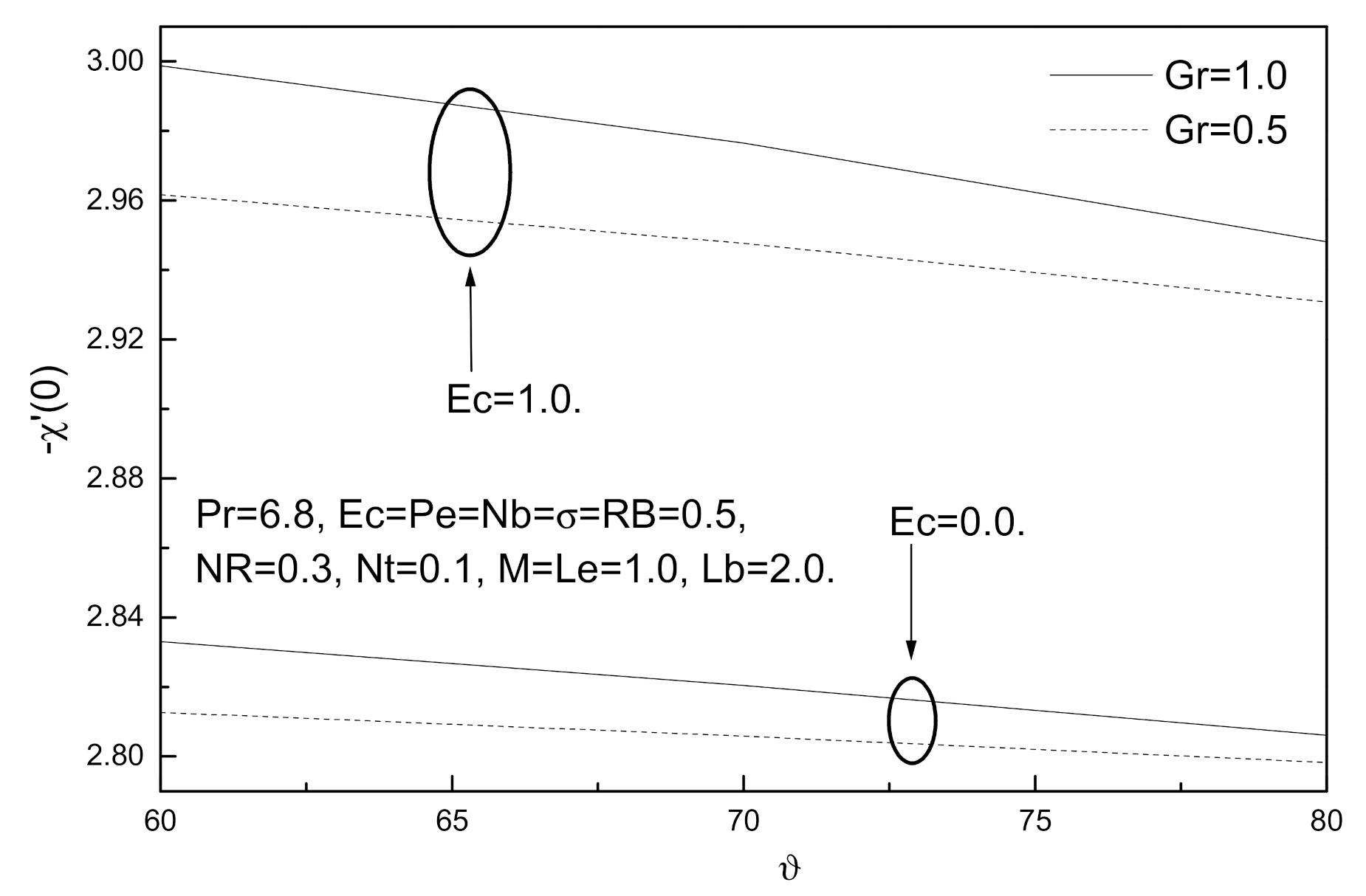
Publisher’s Note: MDPI stays neutral with regard to jurisdictional claims in published maps and institutional affiliations. |
© 2021 by the authors. Licensee MDPI, Basel, Switzerland. This article is an open access article distributed under the terms and conditions of the Creative Commons Attribution (CC BY) license (https://creativecommons.org/licenses/by/4.0/).
Share and Cite
Nabwey, H.A.; El-Kabeir, S.M.M.; Rashad, A.M.; Abdou, M.M.M. Effectiveness of Magnetized Flow on Nanofluid Containing Gyrotactic Micro-Organisms over an Inclined Stretching Sheet with Viscous Dissipation and Constant Heat Flux. Fluids 2021, 6, 253. https://doi.org/10.3390/fluids6070253
Nabwey HA, El-Kabeir SMM, Rashad AM, Abdou MMM. Effectiveness of Magnetized Flow on Nanofluid Containing Gyrotactic Micro-Organisms over an Inclined Stretching Sheet with Viscous Dissipation and Constant Heat Flux. Fluids. 2021; 6(7):253. https://doi.org/10.3390/fluids6070253
Chicago/Turabian StyleNabwey, Hossam A., S.M.M. El-Kabeir, A.M. Rashad, and M.M.M. Abdou. 2021. "Effectiveness of Magnetized Flow on Nanofluid Containing Gyrotactic Micro-Organisms over an Inclined Stretching Sheet with Viscous Dissipation and Constant Heat Flux" Fluids 6, no. 7: 253. https://doi.org/10.3390/fluids6070253
APA StyleNabwey, H. A., El-Kabeir, S. M. M., Rashad, A. M., & Abdou, M. M. M. (2021). Effectiveness of Magnetized Flow on Nanofluid Containing Gyrotactic Micro-Organisms over an Inclined Stretching Sheet with Viscous Dissipation and Constant Heat Flux. Fluids, 6(7), 253. https://doi.org/10.3390/fluids6070253








